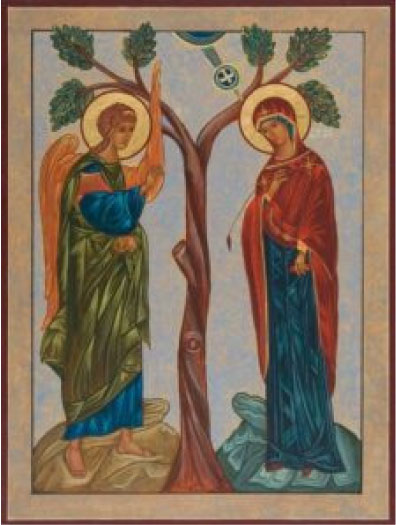
Now that it is the day after the celebration of the Annunciation, the Church calendar sets this day, the 26th of March, apart in honor of the Archangel Gabriel due to his role in bringing the good and joyful news to the Virgin about the incarnation in her womb of the Son of God. A hymn from Great Vespers reflects this story:
In the sixth month, the Archangel Gabriel was sent to the pure Virgin. He said to her to rejoice, and he announced that the Redeemer would be born from her. When she accepted the salutation with faith, she conceived You, the pre-eternal God, Who were well pleased in an indescribable manner to become man in order to save our souls.
Curiously, this hymn begins by telling us that Gabriel came to the Virgin Mary “in the sixth month.” If we were to read this in today’s way of keeping time, we would conclude that this event took place in June. But that is not what is being conveyed. We need to turn to the Gospel story itself, and to the Sacred Scriptures in general, to truly comprehend the mystery.
The first level of meaning is to be found in Luke 1:24-26: “After these days Zachariah’s wife Elizabeth conceived, and for five months she hid herself, saying, ‘Thus the Lord has done to me in the days when He looked on me, to take away my reproach among men.’ In the sixth month the angel Gabriel was sent from God to a city of Galilee named Nazareth, to a virgin… and the virgin’s name was Mary.” So, “the sixth month,” refers to the sixth month of Elizabeth’s pregnancy with John the Baptist in her womb. But there is more to be found here.
Hearkening back to the first chapter of Genesis, we read: “Then God said, ‘Let us make man in our image, after our likeness… So God created man in His own image, in the image of God He created him; male and female He created them… And there was evening and there was morning, a sixth day.” And herein lies the key to understanding the story on a deeper level: since the first man, Adam, was created on the sixth day, and this man sinned and subjected humanity and all of creation to corruption and mortality, the New Adam, our Redeemer Jesus Christ, was conceived in the Virgin’s womb and took on flesh in the sixth month.
St. Paul writes of this mystery in Romans 5: “Sin came into the world through one man and death through sin… And Adam was a type of the One Who was to come… If, because of one man’s trespass, death reigned through that one man, much more will those who receive the abundance of grace and the free gift of righteousness reign in life through the one man Jesus Christ.” As the first man and head of the human race, Adam, caused death to rule over humanity because of his disobedience, the new and perfect Man, as the head of the race of Christians, Christ brings release from death and eternal life to those who believe in Him and love Him.
This is the indescribable joy and mystery of the Annunciation event: the taking on of flesh, the assuming of our human nature by God the Word in order to rescue us from the clutches of death and transfer us into the eternal existence of His glory. Therefore, as citizens of His eternal Kingdom, in thanksgiving and with great faith we can say: “If God is for us, who is against us, and who shall separate us from the love of Christ? Shall tribulation, or distress, or persecution, or famine, or nakedness, or peril, or sword? No, in all these things we are more than conquerors through Him Who loved us” (Romans 8:31-37).